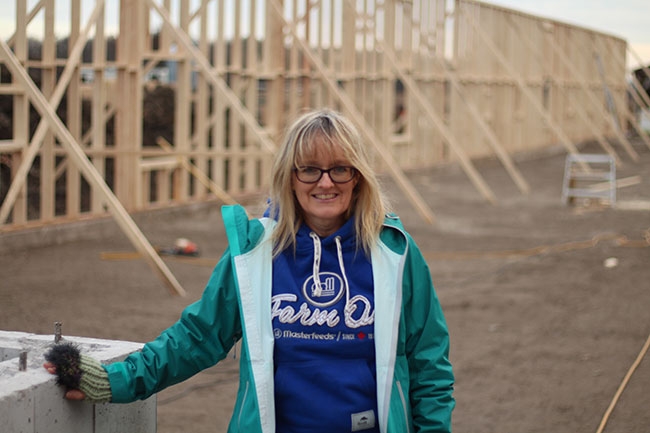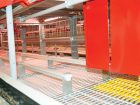
Layer housing: Build new or retrofit?
By Treena Hein
Features Equipment Layers Poultry Equipment Production Alternative poultry housing Animal Housing annex Cage free Canada Cindy Egg Farmerette Egg production Production ProfilesIt’s a complex question egg farmers must answer as they shift away from conventional housing.
 Cindy Huitema and her husband Nick tore down an old pig barn and are using its foundation to build a new layer barn with enriched cages. They estimate this approach will save them about $70,000.
Cindy Huitema and her husband Nick tore down an old pig barn and are using its foundation to build a new layer barn with enriched cages. They estimate this approach will save them about $70,000. As the Canadian egg industry phases out conventional cages, most farmers will decide to install free-run or enriched cage housing. For its part, poultry housing maker Big Dutchman is presently seeing a 50/50 split on its Canadian sales of the two housing types, but sales lead Ron Wardrop says he’s recently seeing a little more interest from producers in enriched cages.
Whatever type of housing farmers choose, they also must decide whether to do a complete teardown and build a new barn or retrofit an existing barn. Housing and equipment is the capital cost in egg production, notes Big Dutchman aviary specialist Bill Snow.
Operational costs include ongoing maintenance, feed, heating and electricity, rearing, labour and vaccination.
What you spend and how you spend on your building and housing system will affect your operational costs, Snow says, and careful decision-making upfront will minimize long-term costs in terms of not only money but bird welfare and performance down the road.
Factors to consider
While it’s not always possible, Snow observes that new construction is ideal because you can design a building to the exact size required. “The exact size takes everything into account – aisle widths, bird numbers, ventilation, lighting and design for management and bird movement,” he explains. “With a new build, you also have the exact height of the building needed for the equipment you’ve chosen and proper spacing for everything. Fan placement and air inlets are where they need to be, and everything is planned for the bird number you have. You are not having to sacrifice.”
Simply put, sacrifices in the placement of lighting and ventilation obviously present risks to layer performance. That is, if the placement of lights and ventilation and heating ducts is not uniform, birds will group around what they perceive as the only resources that are available to them (whereas they will not group if resources are uniformly spaced).
Grouping due to perceived scarcity of food, water and roost space at night creates a competitive mindset in the birds, often resulting in higher levels of aggression, stress, injury and mortality. “The point is that if a farmer doesn’t ensure that equipment is placed properly, the whole environment won’t be one that’s best for hen welfare,” Snow explains. “We must have that good environment for hens to feel comfortable laying their eggs and to ensure those eggs are not subject to cracking and other quality issues.”
He notes that with enriched colony housing, you have more control over the environment (lighting and temperature in particular) and are, therefore, better able to provide an optimized laying environment for hens. However, maintenance is higher than with free-run housing. On the other hand, cage-free systems require a bigger building footprint.
Retrofits of an existing building are easier for enriched systems versus cage-free, but Snow again stresses that you need the correct ventilation and lighting layouts either way. “I guess it really depends on what lengths you are willing to go to in the retrofitting,” he reflects. “If you have a solid barn, it can still be used. You just need to make sure that you are not driven in your decision by bird numbers – that you are not fitting a system into an existing house to get a desired bird number. While this can work, you need to make sure you are fully informed about how any sacrifice can affect your barn’s performance and, therefore, your hens’ performance.”
He believes a retrofit can work very well for a cage-free flock as long as the new housing system ensures good flock movement and enables daily management that can be performed at a high level with ease. He reiterates that, in the end, it’s all about hen welfare and supporting the hens to lay.
“Many houses are in great shape and are working very well right now for farmers,” Snow notes. “Farmers really need to understand how each variable or element of cage-free or enriched affects performance and hen welfare. It is not just simply fitting a new system into an existing house, achieving bird numbers and getting desired results. Enriched is an easier environment to control, but management, ventilation, lighting, flock size and aisle widths are factors that will change performance and must be examined and understood.”
Al Dam, poultry specialist with the Ontario Ministry of Agriculture, Food and Rural Affairs, agrees. “You can try to make an aviary out of a cage barn,” he concludes, “but you may be better off getting a new building if there are too many limitations with what you have now, such as ventilation, feed, water, building footprint, heating and so on.”
Producer decision
Cindy and Nick Huitema, who farm 9,000 layers near Dunnville, Ont., are currently building a new barn for 12,000 layers. It’s a new build with a touch of retrofit tossed in – they’ve torn down an old pig barn and are using its foundation for the new barn, with the foundation extended at the front with new cement. Nick believes using the existing foundation will save them about $70,000 over having to start from scratch.
In terms of their decision-making process, Cindy notes that going to the poultry show in London,Ont. was very useful in that it allowed her and her husband to see all the different housing types in one place. “Touring barns and going to open houses is also very important,” she says. “You can talk to the farmer and industry people and ask questions.”
The Huitemas chose an enriched colony system from Clark Ag Systems and used a consultant there who had a lot of experience. One thing that stand outs for Cindy about the entire process is the need to make sure the barn’s packing room and cooler are spacious and well-lit, as a lot of time will be spent there over the years and it should be comfortable.
Snow doesn’t know if there is any financial difference in a tear-down/new build versus a retrofit, but certainly factors such as the capabilities and expertise of your contractor, the size of the buildings and the current condition of the building will play a role in what costs turn out to be. “I think a tear-down and rebuild might be faster, but that’s just a thought,” he adds.
“What matters is, as I’ve said, don’t sacrifice with what you’re putting in. If you can retrofit and not sacrifice in terms of providing the right conditions for good bird welfare and performance and also to have an environment that people will want to work in, then do it. You are paying for the building one time but if you don’t do it right, you will be paying for it in other ways for a long time to come.”
In deciding to re-build or retrofit, farmers should work with at least one consultant who will visit, do research and then discuss the winning scenario. “It’s a big decision, but once the research is all done,” says Snow, “the best option should become clear.”
Print this page

